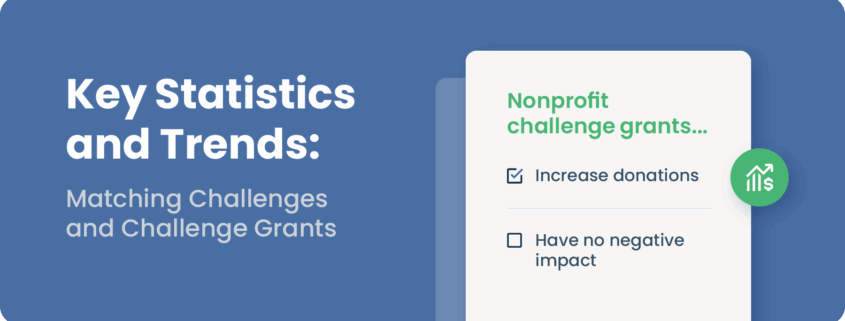Key Statistics and Trends in Matching Challenges and Challenge Grants
Challenge matches have emerged as some of the most effective tools in nonprofit fundraising. Whether you’re seeking to engage donors, increase average gift size, or close year-end gaps, these initiatives deliver measurable results. In this article, we’ll share the most recent matching challenge trends and statistics, supported by research and industry data, to demonstrate why these tools should be central to your fundraising strategy.
What Are Challenge Grants and Matching Challenges?
Challenge grants are fundraising offers in which a donor agrees to match donations made by other supporters, often up to a specified amount. These grants are designed to encourage additional donations by creating a sense of urgency, motivating donors to give so their gift can be matched.
Matching challenges take this concept one step further by setting specific fundraising goals or deadlines (often during high-traffic periods like Giving Tuesday or year-end). These challenges often lead to higher levels of engagement and dramatically increase the funds raised.
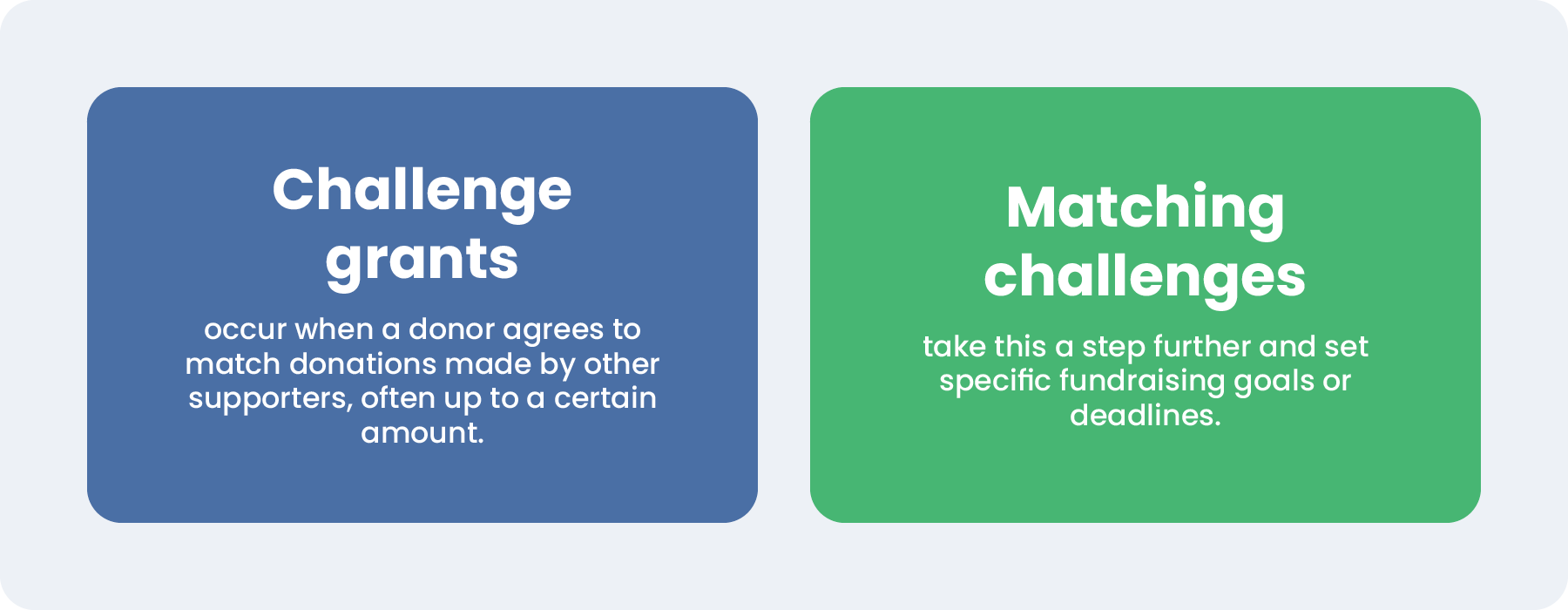
Key Challenge Match Statistics for 2025
1. 100% of top peer-to-peer fundraising organizations use some form of matching challenge.
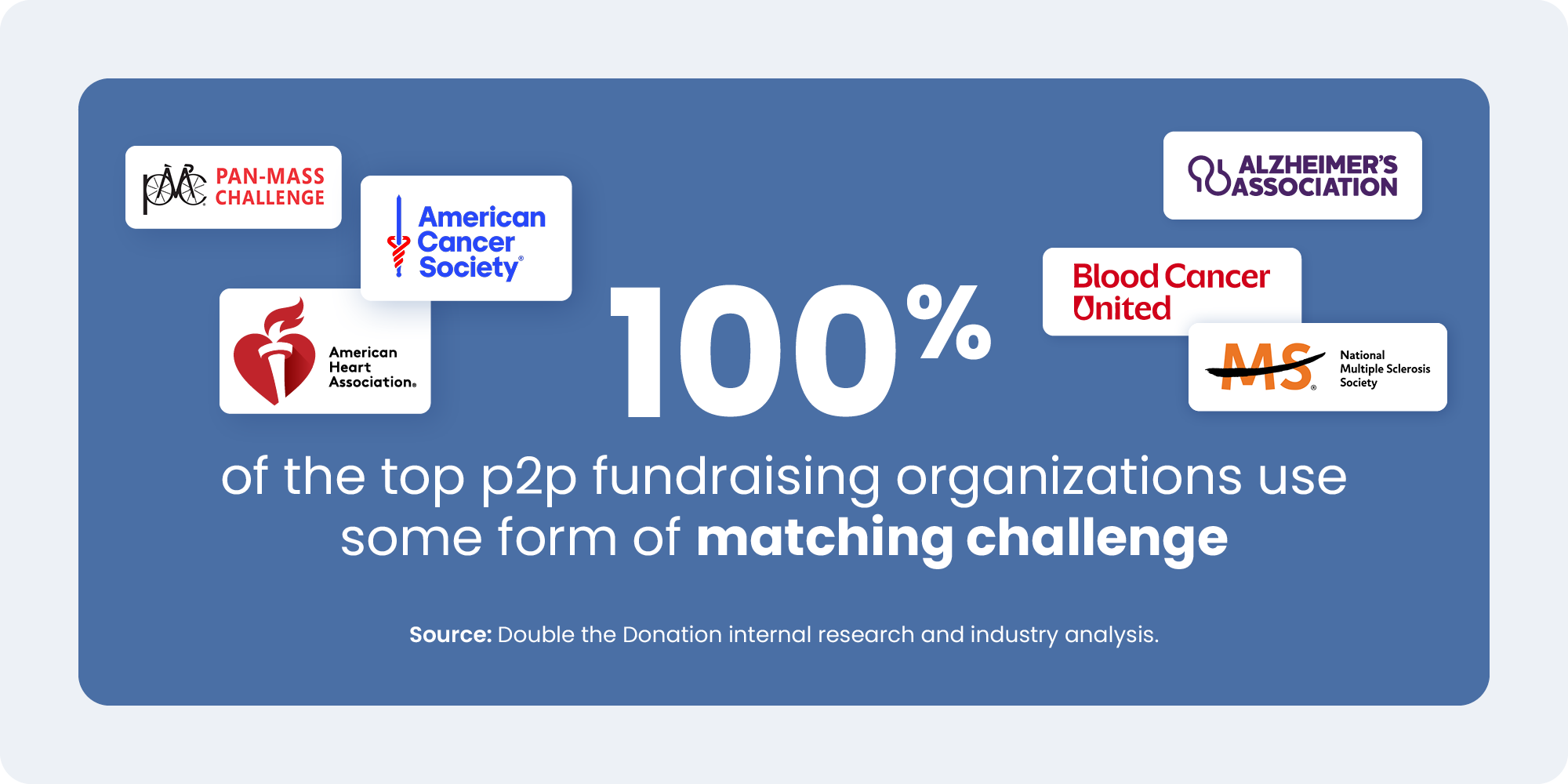
Source: Double the Donation
According to Double the Donation’s industry research, 100% of top peer-to-peer fundraising organizations use some form of matching challenge in their efforts. This remarkable statistic speaks volumes about the strategy’s effectiveness. When every leading nonprofit in the peer-to-peer space is using matching challenges, it’s no longer just a best practice; it’s a proven, indispensable part of a successful fundraising toolkit.
Why are matching challenges so powerful? At their core, they tap into human motivation and social proof. When donors know their gifts will be doubled (or even tripled), they feel their impact is amplified. That emotional boost inspires more people to give, give sooner, and often at higher levels. And when fundraisers communicate that a matching challenge is in play, it creates a sense of urgency; donors understand their participation matters now.
2. Campaigns with matching components raise 3–5x more than those without.
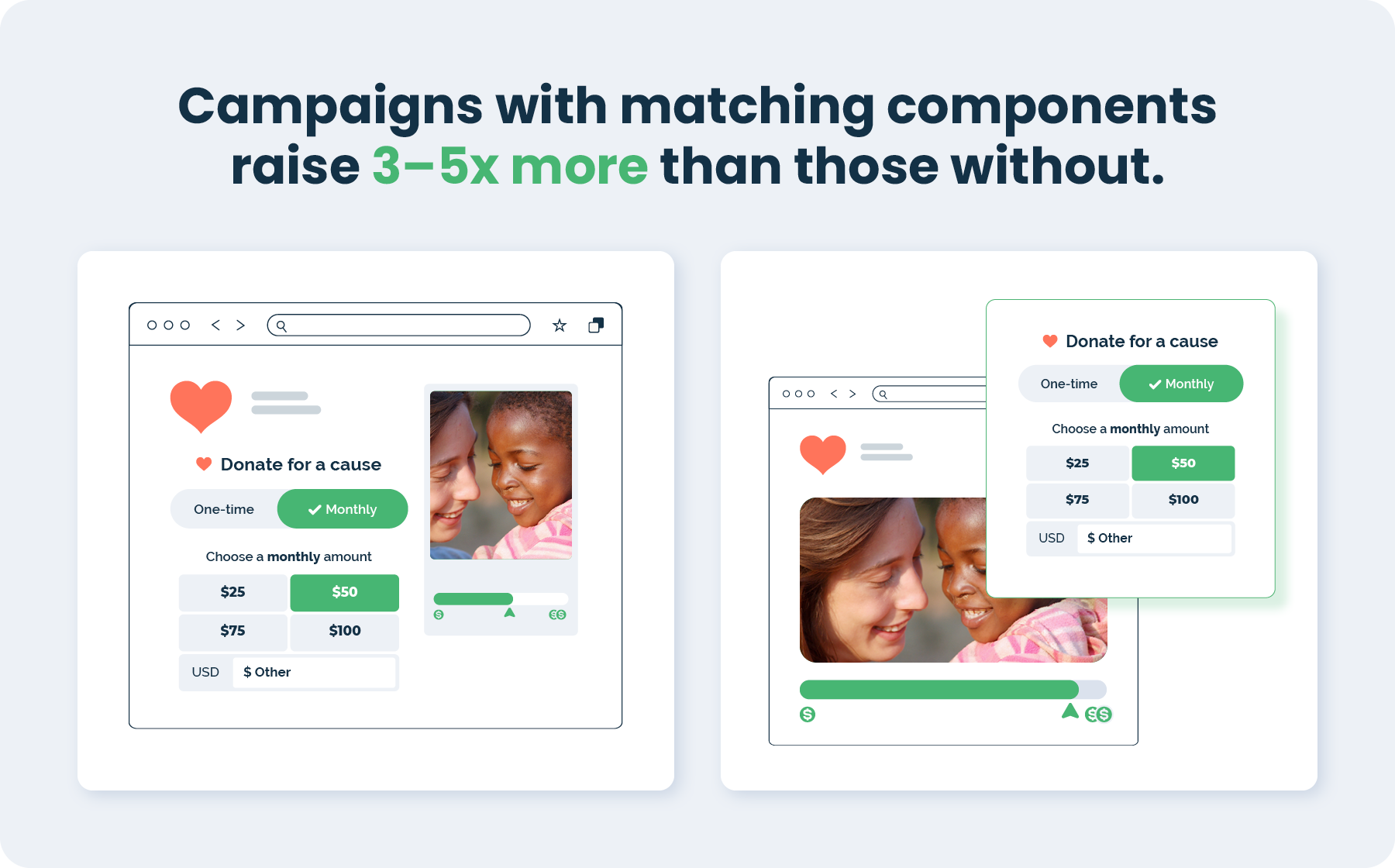
Source: Philanthropy News Digest
Recent studies show that adding a match component can increase the total amount raised during a campaign by up to five times. The psychological effect of having a donation matched creates a sense of urgency, motivating donors to contribute quickly and increase their gift sizes.
This boost is not limited to major donors; smaller contributions also grow when donors know their impact is amplified. By tapping into this sense of urgency and collective purpose, nonprofits can significantly increase both participation and total funds raised, making matching challenges a powerful tool for campaign success.
3. 100% of nonprofits surveyed increased their fundraising through challenge matches.
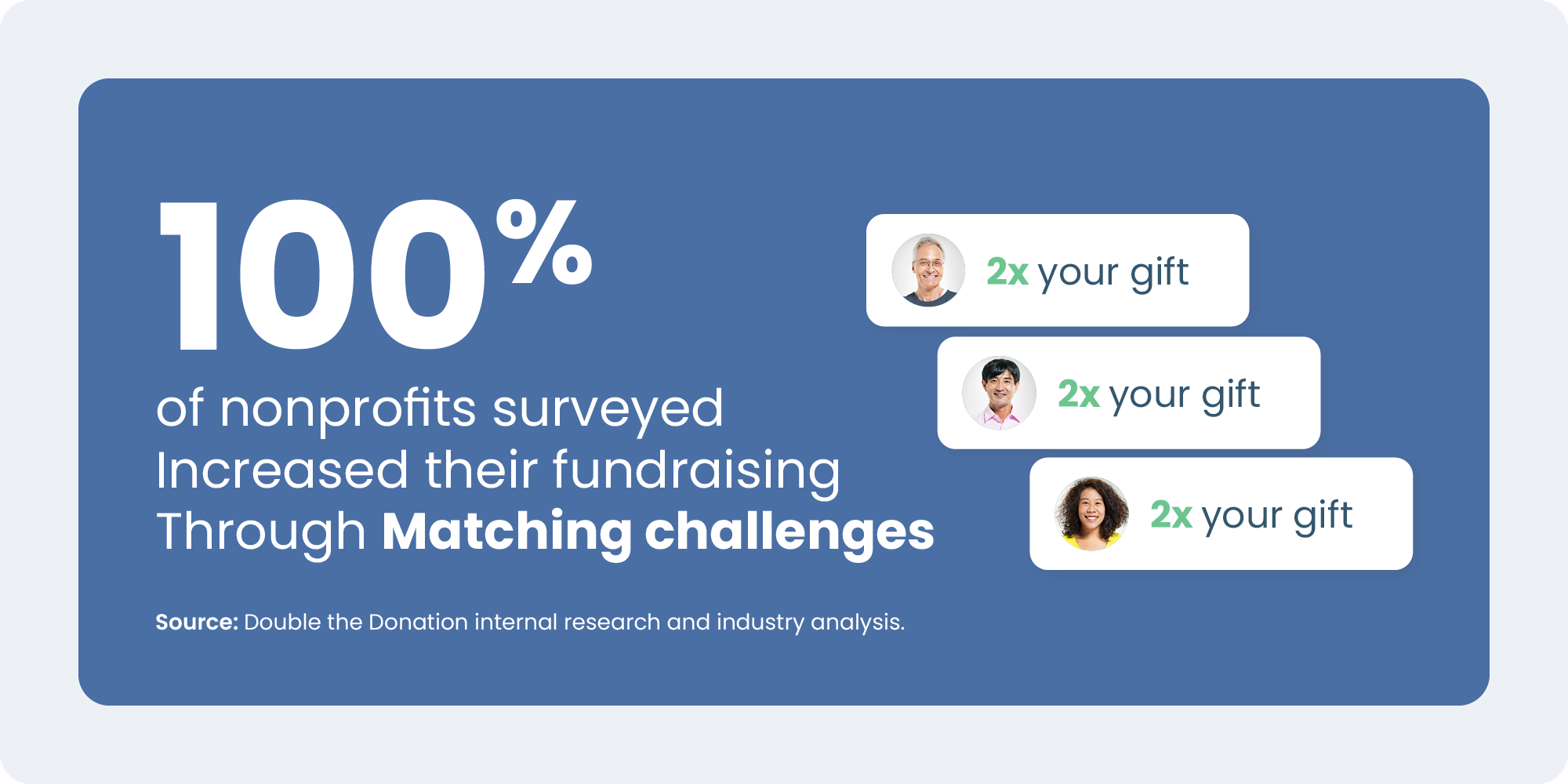
Source: 360MatchPro
Campaigns featuring challenge matches and grants consistently outperform those without. This shows how effective matching components are in boosting campaign results. When donors know their gifts will be matched, they’re more likely to contribute and often increase their donation amounts. Challenge matches also attract new donors, as the promise of a doubled or tripled impact motivates first-time supporters to get involved.
4. 84% of donors say a match increases their likelihood to donate.
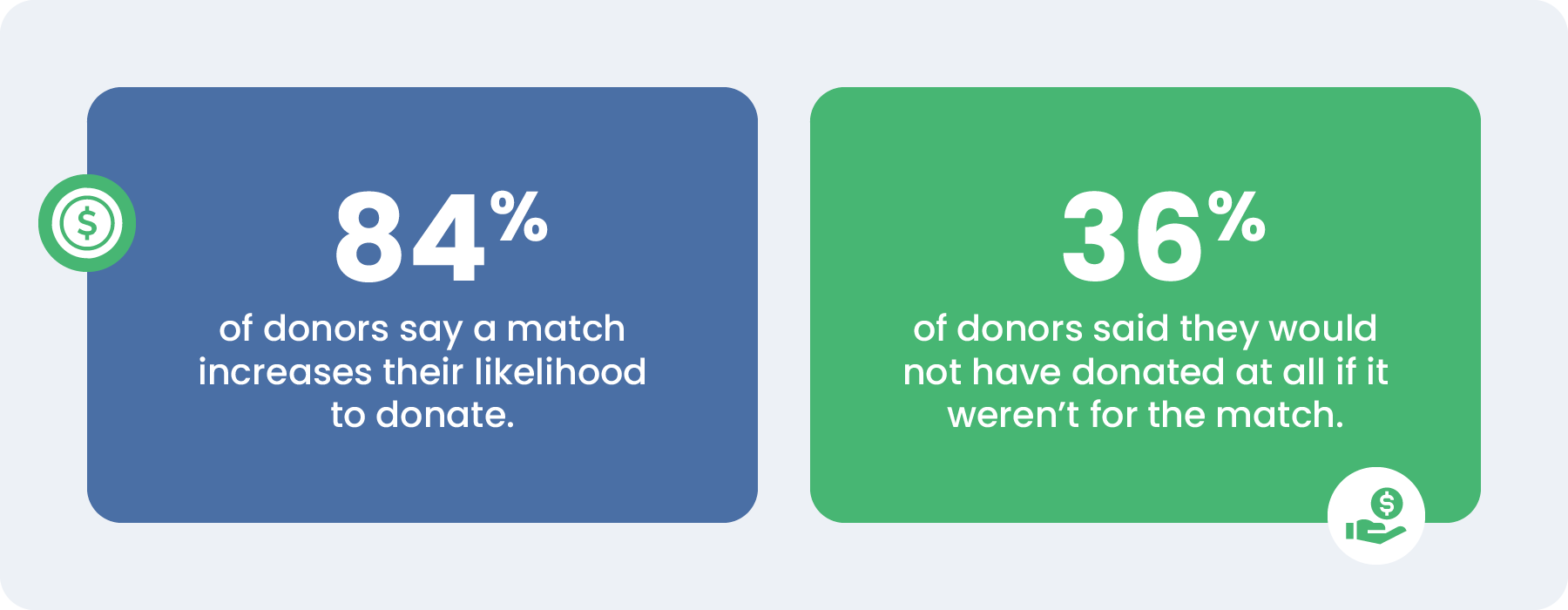
Source: The Big Give
According to a survey by The Big Give, a significant 84% of donors report that they are more likely to contribute when they know their gift will be matched. This strong preference highlights the motivational power of matching gifts. The promise of a matched donation not only encourages existing donors to give more, but it also draws in new supporters who might not have otherwise contributed.
5. 58% of surveyed nonprofits say email campaigns are their primary channel for promoting challenge matches.
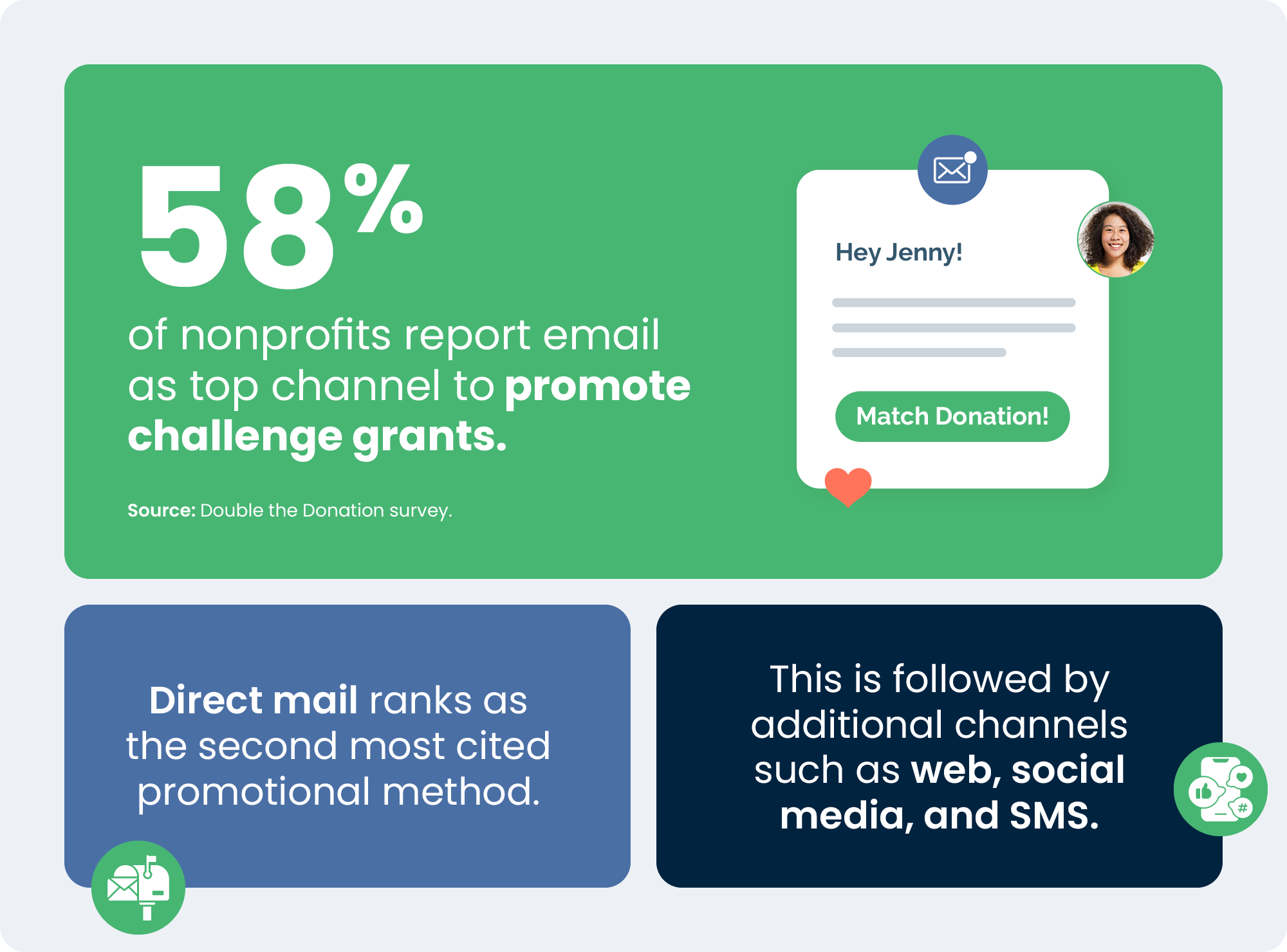
Source: Double the Donation
6. Only 16% of surveyed nonprofits report promoting challenge matches on their website.
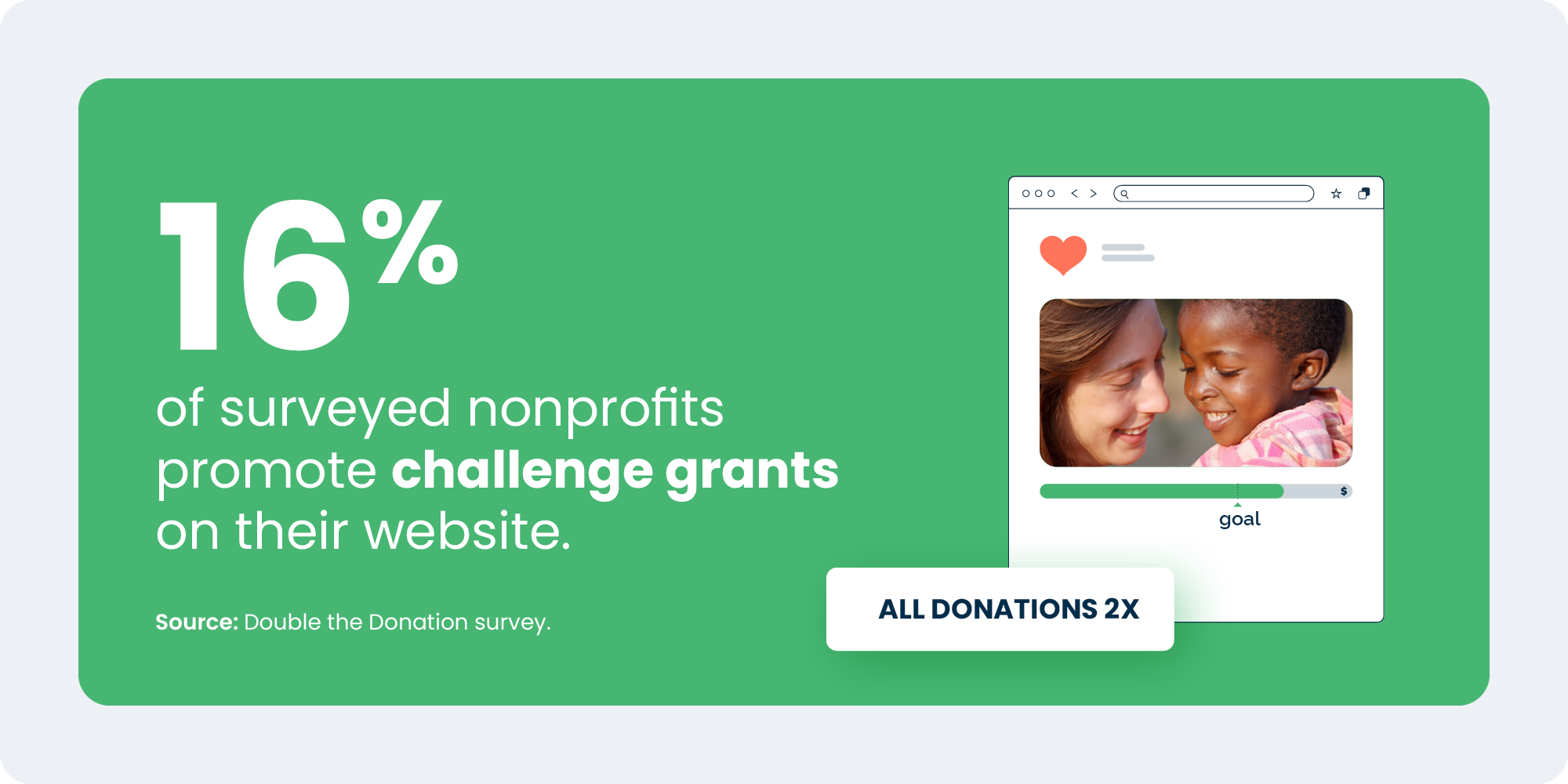
Source: Double the Donation
Despite the internet being a critical fundraising tool, many nonprofits appear to struggle with integrating match opportunities effectively on their websites. Research indicates that only 16% of surveyed nonprofits promote challenge matches on their websites, which reveals a significant missed opportunity for organizations to engage supporters in real-time.
Websites serve as a central hub for information and donor interaction, making them an ideal platform for promoting challenge match opportunities. By not prominently featuring these campaigns, nonprofits may be missing out on potential donations and the chance to further engage visitors.
7. 64% of surveyed nonprofits run year-end challenge match campaigns.
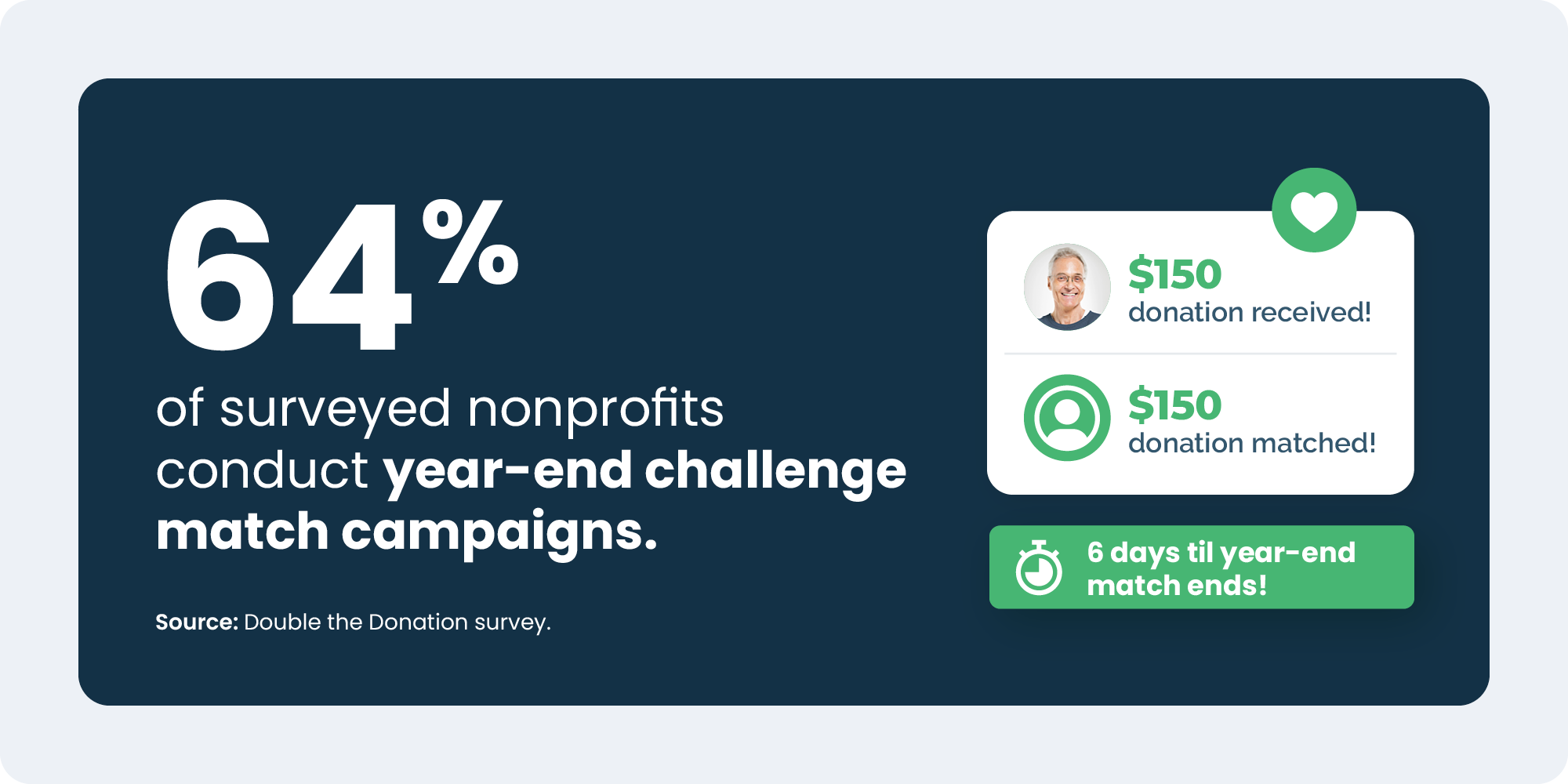
Source: Double the Donation
According to industry research, 64% of surveyed nonprofits run year-end challenge match campaigns, making this the most popular time for such efforts. The final weeks of the calendar year are marked by heightened donor urgency and generosity, driven by tax incentives and a strong sense of giving during the holiday season. This creates a prime opportunity for nonprofits to maximize donations through matching challenges.
Challenge Match Trends for Nonprofits to Leverage
In order to best utilize the above matching challenge trends and challenge grant statistics in your fundraising, it helps to be familiar with current and expected trends regarding the programs. Here’s what we’ve seen recently, and what we expect to see in the near future.
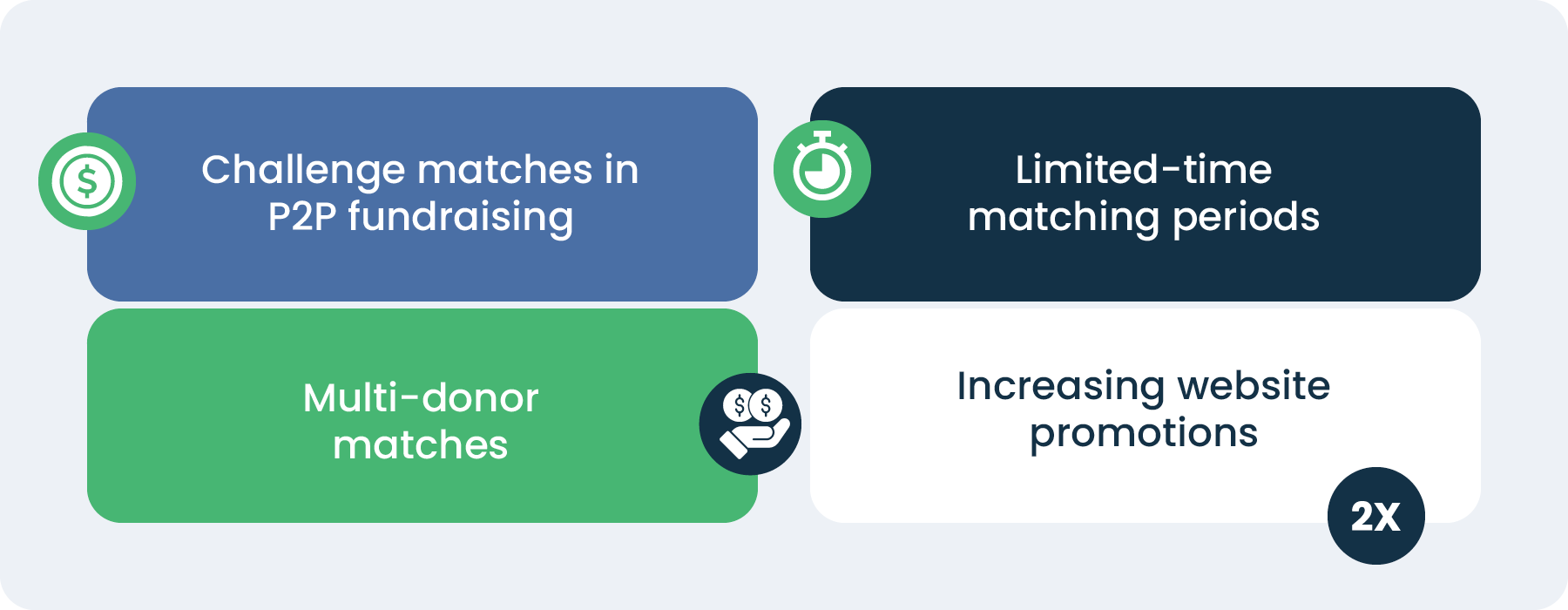
1. Challenge Matches Are Appearing in Peer-to-Peer Fundraising
More nonprofits are incorporating challenge grants or matching challenges into peer-to-peer fundraising efforts. Peer-to-peer campaigns, which encourage donors to fundraise on behalf of a nonprofit, benefit greatly from challenge matches, as they inspire participants to meet higher donation goals with the added incentive of amplified impact.
2. Multi-Donor Matches Are Becoming More Common
In addition to major individual donors, nonprofits are increasingly tapping into multi-donor match pools, where several donors contribute to a collective fund. This strategy spreads the financial responsibility out and engages a wider network of supporters, allowing more nonprofits to offer these initiatives.
3. Limited Time Matching Periods Are Driving Action
Nonprofits are inciting a sense of urgency by setting time-limited matching periods. For example, offering a match that’s only available for the first 48 hours of a campaign increases immediate contributions and boosts the momentum of fundraising efforts.
Pro Tip for Nonprofits:
If you’re offering a challenge grant, clearly communicate the match deadline to create a sense of urgency. Consider countdown timers in your emails or on your fundraising page.
4. Promoting Your Challenge Grant on Your Website Unlocks Results
While email is still the most common channel, promoting challenge matches and grants directly on your website is an underutilized strategy that can drive real growth. Your website is visited by supporters, potential major donors ready to activate their own challenge grant, and corporations alike. Making sure that challenge match availability is visible here is critical.
Nonprofit Success Stories: Amplifying Impact with Challenges
Challenge grants and matching challenges tap into a sense of competition to drive real results for fundraising teams. Here’s how some nonprofits are benefiting from these strategies:
-
Oasis for Orphans:
Oasis for Orphans implemented a match around Giving Tuesday and saw $50,000 generated from the initiative! They promoted the match in email headers and website promotions to get their donors aware of and interacting with the opportunity.

-
Fresno Chaffee Zoo:
Fresno Chaffee Zoo launched a matching challenge aligned with World Elephant Day, helping them spur action from donors interested in their mission in a very targeted amount of time!
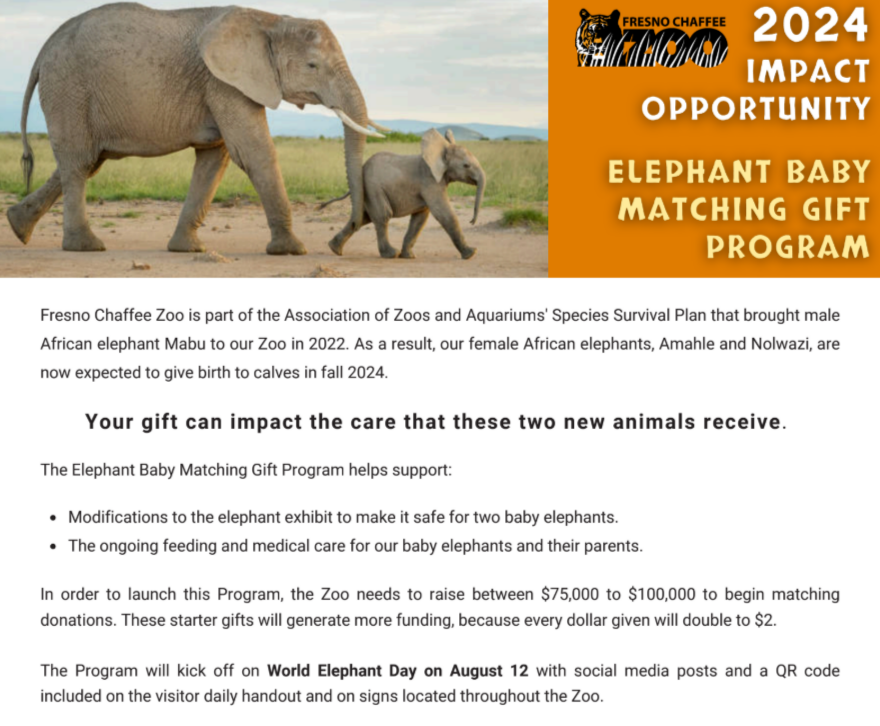
These case studies demonstrate how offering any kind of matching opportunity to donors not only drives donations but also increases loyalty and engagement.
How to Make the Most of a Challenge Match
If you’re ready to incorporate a challenge match into your fundraising strategy, here are some steps to maximize your success:
1. Set a Clear Match Limit and Deadline
Donors are more likely to respond when they know the exact parameters of the match. Be transparent about:
-
How much will be matched (e.g., “Every gift up to $25,000 will be doubled”).
-
Who is providing the match (a major donor, foundation, or donor pool)?
-
When the match expires (e.g., “This opportunity ends at midnight on December 31”).
Setting a deadline creates urgency, while a clearly defined cap helps manage donor expectations and motivates action before the limit is reached.
2. Promote Across Multiple Channels
Don’t rely solely on email. While it may be the most used channel and is effective, reaching out across a few channels is key to reaching more donors. Consider a combination of these channels, leveraging each channel’s strength:
- Email: Announce the match, share updates, and remind donors of the deadline.
- Website: Add a homepage banner, donation page alert, or pop-up about the match.
- Social Media: Use urgency-driven posts, live updates, and video testimonials to promote.
- Direct Mail: Especially effective for older donors, include a match insert or header on printed appeals.
- Text Messaging: Great for quick deadline reminders if you have opted-in donor phone numbers.
3. Report Progress Regularly
Keeping donors informed about how close you are to reaching the match goal builds excitement and trust.
-
Send updates like “We’re 65% of the way to unlocking the full match!”
-
Use visuals such as thermometers or progress bars on your site and in emails.
-
Provide mid-campaign updates across social media and newsletters to re-engage supporters.
These updates can inspire donors to give again or share the campaign with others to help close the gap.
4. Follow Up with Matched Donors
Post-campaign follow-up is essential for stewardship and future success. After the campaign:
- Send a personalized thank-you to each donor that makes it clear their gift was matched.
- Share the final results of the campaign (“Thanks to your support, we raised $75,000, including the full $25,000 match!”).
- Tell the impact story and explain how the funds will be used to advance your mission.
- Offer ways to stay involved, such as recurring giving, volunteer opportunities, or upcoming events.
The Takeaway: Challenge Matches Work
The data is clear: challenge grants and matching challenges are some of the most effective tools available to nonprofits today. These matching challenge trends help drive urgency, increase gift amounts, and bring in donors who might not have given otherwise.
By integrating the above strategies, especially with stronger website promotion and simpler campaign management, nonprofits can unlock even more year-round fundraising potential.

